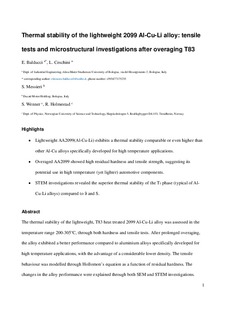| dc.contributor.author | Balducci, E | |
| dc.contributor.author | Ceschini, L | |
| dc.contributor.author | Messieri, S | |
| dc.contributor.author | Wenner, Sigurd | |
| dc.contributor.author | Holmestad, Randi | |
| dc.date.accessioned | 2018-01-05T13:43:39Z | |
| dc.date.available | 2018-01-05T13:43:39Z | |
| dc.date.created | 2017-07-11T14:29:02Z | |
| dc.date.issued | 2017 | |
| dc.identifier.citation | Materials & design. 2017, 119 54-64. | nb_NO |
| dc.identifier.issn | 0264-1275 | |
| dc.identifier.uri | http://hdl.handle.net/11250/2476052 | |
| dc.description.abstract | The thermal stability of the lightweight, T83 heat treated 2099 Al-Cu-Li alloy was assessed in the temperature range 200–305 °C, through both hardness and tensile tests after overaging. After prolonged thermal exposure, the alloy exhibited a better performance compared to aluminium alloys specifically developed for high temperature applications, with the advantage of a considerable lower density. The tensile behaviour was modelled through Hollomon's equation as a function of residual hardness. The changes in the alloy performance were explained through both SEM and STEM investigations. Microstructural analyses gave evidence of Ostwald ripening, while fractographic analyses revealed a transition from an intergranular to a ductile fracture mechanism in the overaged alloy. STEM investigations highlighted the superior thermal stability of the T1 phase compared to ϑ and S strengthening phases, which dissolved during overaging at 245 °C. The study underlines the need to enhance the formation of T1 precipitates when high temperature strength is required. The results of the present study suggest that the 2099 alloy is a very promising candidate for automotive engine components, which are extremely demanding in terms of both thermal resistance and lightweight. | nb_NO |
| dc.language.iso | eng | nb_NO |
| dc.publisher | Elsevier | nb_NO |
| dc.title | Thermal stability of the lightweight 2099 Al-Cu-Li alloy: Tensile tests and microstructural investigations after overaging | nb_NO |
| dc.type | Journal article | nb_NO |
| dc.description.version | submittedVersion | nb_NO |
| dc.source.pagenumber | 54-64 | nb_NO |
| dc.source.volume | 119 | nb_NO |
| dc.source.journal | Materials & design | nb_NO |
| dc.identifier.doi | 10.1016/j.matdes.2017.01.058 | |
| dc.identifier.cristin | 1481928 | |
| dc.relation.project | Norges forskningsråd: 221714 | nb_NO |
| dc.relation.project | Norges forskningsråd: 197405 | nb_NO |
| dc.description.localcode | This is a submitted manuscript of an article published by Elsevier Ltd in Materials & Design, 21 January 2017. | nb_NO |
| cristin.unitcode | 194,66,20,0 | |
| cristin.unitname | Institutt for fysikk | |
| cristin.ispublished | true | |
| cristin.fulltext | preprint | |
| cristin.qualitycode | 1 | |
